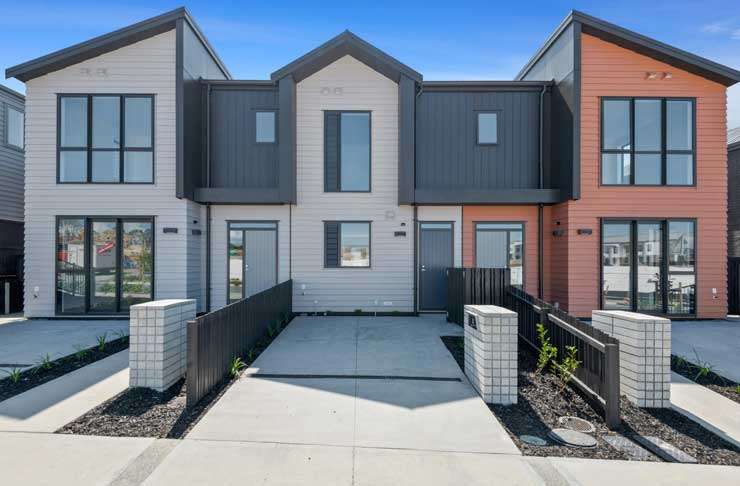- This content was created in partnership with Kāinga Ora
Kāinga Ora’s manager of home ownership, Jason Lovell, says the Government’s home-builder has evolved hugely since the days when its role was limited to state housing.
“We don't just do social housing,” says Lovell. “We administer and deliver the government's homeownership assistance products. Our products are not just for people living in our homes. But for all New Zealanders.”
Around a third of the homes Kāinga Ora commissions in its developments are sold on the open market. They are a mix of apartments and terrace homes.
Start your property search
First home buyers who are eligible and some previous homeowners get an extra leg up through programmes such as KiwiBuild, the KiwiSaver First Home Grant, and Kāinga Ora’s First Home Partnership (shared ownership).
An example of the homes it’s building is work underway currently in Te Kauwhata, in Waikato, handily placed on the corridor between Auckland and Hamilton.
“In the first stage of a Kāinga Ora-backed development there’ll be around 220 homes of which approximately 20% will be priced at an affordable level, an example being a $650,000, 3-bedroom home,” says Lovell. More homes are in the pipeline currently at Hobsonville Point and also an expansion of affordable homes in the Rotowhare development in Rotorua.
Group builders
KiwiBuild and affordable homes such as the Axis Series at Hobsonville, are highly sought after thanks to their lower price point. Qualifying buyers go into a ballot for the chance at picking up these homes.
Universal Homes sales consultant Lisa Fleming sells both Axis homes and open market homes in Kāinga Ora’s Hobsonville Point development. The price points for the Axis homes are set by Kāinga Ora at $550,000, $600,000 and $650,000. The open market homes commissioned by Kāinga Ora and built by Universal homes start from $795,000 and range up to $1.5m, says Fleming.

Kāinga Ora homes in Auckland’s Hobsonville Point. Photo / Supplied
In the early days of Hobsonville Point buyers assumed it would be a combination of Nappy Valley and social housing, says Fleming. The reality is that it turned out to be a highly sought-after location to live. The association with Kāinga Ora doesn’t dent demand. “People sweat blood to get into Hobsonville,” says Fleming.
The ballot
Scott Muirson, a real estate agent who owns SMProperty, an agency specialising in new homes, has recently sold a number of homes in Kāinga Ora’s Mount Roskill development, where 11,000 houses are being built in total.
The agency teamed up with Flip Homes to sell six open market and three KiwiBuild homes. The three KiwiBuild homes drew around 400 applicants in the ballot.
Some of Muirson’s clients who qualified for KiwiBuild but were unsuccessful at ballot went onto buy the open market homes priced between $825,000 and $850,000.
It has been a mental leap for some buyers to go into a Kāinga Ora development, says Muirson. In the beginning many are concerned about the percentage of state/social housing in the development. The Roskill Development, for example, is made up of 3,000 state homes, 3,500 affordable homes and 3,500 for the open market.
Muirson, who himself lives in a street with social housing sees the positives. “Being in Mount Roskill, it was quite close to the central city and there is not a lot of affordable housing in the area. (The presence of social housing) was the lesser of two evils.”
First Time Partner
Late last year Kāinga Ora launched its shared ownership scheme: First Home Partner. Shared ownership is common overseas. Buyers who qualify buy a majority percentage of the home and the partner, in this case Kāinga Ora also contributes an agreed amount, to the purchase, buying a proportion of the home.
The maximum contribution Kāinga Ora will make towards a purchase is 25% or $200,000.00, whichever is lower.

11,000 new homes are planned for Kāinga Ora’s development in Mount Roskill, Auckland. Photo / Supplied
The purpose of this scheme is to help first home buyers who earn enough to cover a standard home loan but don’t have sufficient deposit.
Buyers need to have a total household income before tax of no more than $130,000, be a first home buyer, have a good credit rating, and be buying a brand-new home. They also need to have a 5% deposit.
“(When people) contact us about KiwiBuild property for example, we're actually making them aware of the opportunity with this First Home Partner,” says Lovell.
The advantage for buyers with First Home Partner, is that they’re not restricted to buying within a Kāinga Ora development. “You go and find the property and it’s not restricted by location,” says Lovell.
Around 2,000 New Zealanders registered for First Home Partner between October 2021 when it launched to mid-January 2022, and 339 assessed as eligible to buy.
Muirson says he believes the real estate industry and developers need to step up for the First Home Partner scheme. Developers, he says, are not yet comfortable with the idea of having a different sale and purchase agreement for First Home Partner purchase.
“We need to get behind this,” says Muirson. “A lot of the buyers are struggling to find developers who will accept the terms (in the sale and purchase agreement).” It does require more admin from real estate agents and developers, but is worthwhile, he says.
Find out more
Lovell says buyers can stay informed about releases in their chosen development by registering interest through the individual developments’ websites such as Roskilldevelopment.co.nz, Northcotedevelopment.co.nz, and Poriruadevelopment.co.nz.
For more general details on the large-scale projects that will have affordable homes; on KiwiBuild developments and information on how Kāinga Ora can help people get into a home with its suite of financial products can be found on these pages:
- List of Kāinga Ora developments
- Home-ownership under Kāinga Ora: What you need to know
- Kāinga Ora's guide to KiwiBuild








